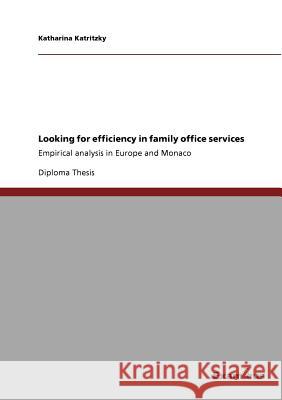Looking for efficiency in family office services: Empirical analysis in Europe and Monaco » książka
Looking for efficiency in family office services: Empirical analysis in Europe and Monaco
ISBN-13: 9783656990949 / Angielski / Miękka / 2012 / 74 str.
Diploma Thesis from the year 2010 in the subject Business economics - Business Management, Corporate Governance, grade: 1, International University of Monaco, language: English, abstract: The past decades have seen an impressive growth in private wealth on agiobai scale. As a measure of this trend, Forbes magazine, in its ranking of the world's richest people 20 years ago, listed around 140 billionaires. In 2010, the list contained 1,011, an increase of 218 compared to 2009, but still shy of the record 1,125 in 20081 Businessmen and other affluent investors are very good at creating wealth, but they are not necessarily as skillful or interested in managing their assets. They depend more and more on financial professionals to advise them on increasingly demanding wealth management issues. During the 19th century, trusts have been developed as a set of legal techniques for protecting the assets of individuals and business entities from creditors and as a way to secure an orderly transfer of wealth. When dealing with the next generation, instead of answering to the single patriarchal founder, trustees have to respond to several siblings and cousins. This increased complexity coupled with broader financial, fiscal, lifestyle and family demands have lead to the development of family offices. The underlying concept is to have all the financial and family related services that one particular family needs in one single office. This model has become a highly valued service model because it facilitates managing complexity. Moreover, the family office allows for secrecy, on-demand availability, transparency, holistic advice and support for the family whenever needed. Due to the value of the family office service model for the wealthy and with the objective to secure existing and attract new business, the financial industry has been trying extremely hard over the past years to adapt this concept. Most of the major banks today have added a "family office service" type structure











